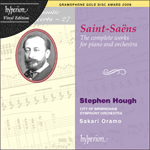The Third Concerto was composed in 1869, soon after No 2. A constantly engaging, original and fascinating work, it is undeserving of its reputation as the weakest of the five. At its premiere in the Leipzig Gewandhaus, the indeterminate tonality at the beginning of the slow movement caused a fracas among a rowdy element of the audience. The first movement opens with a simple but marvellously effective wash of piano arpeggios, apparently inspired by Alpine waterfalls. Against this background a majestic theme (superficially reminiscent of the opening of Schubert’s Ninth Symphony) is heard, initially shared between horn, clarinet and bassoon. Such a description may well suggest a potent, typically Romantic atmosphere, but actually this opening is informed by Saint-Saëns’s characteristic objectivity of tone. While broadly observing classical sonata-form structure, Saint-Saëns constantly modified its conventions. For instance, his fondness for cadenza-like passages contributes a more flexible and rhapsodic quality. Thus, in the opening movement of the Third Concerto, the inclusion of cadenzas both before and after the animated and inventive development section gives the structure an unorthodox twist.
The slow movement – after the initial instability – creates a poignantly beautiful atmosphere. Its second main theme is a bold striding melody for the soloist’s left hand only, while the central section of the movement is characterised by tenderly poetic piano figuration. Following without a break, the finale begins with an anticipatory orchestral section, before the piano bursts in with a robust, swaggering theme. This movement has tremendous, infectious energy, with exuberant cascades of notes in the solo part. Nevertheless, one contemporary critic, presumably disturbed by the importance of the orchestral contribution, hailed it as signalling ‘the death of virtuosity’!
from notes by Phillip Borg-Wheeler © 2001
Le Troisième concerto fut composé en 1869, peu de temps après le deuxième. D’une constante séduction, originalité et fascination, il ne mérite pas d’être réputé le plus faible des cinq. Lors de sa création au Gewandhaus de Leipzig, la tonalité indéterminée du début du mouvement lent causa un esclandre de la part d’une faction au sein de l’auditoire. Le premier mouvement commence, de manière toute simple mais merveilleusement efficace, par un flot d’arpèges au piano, inspiré, semble-t-il, par le souvenir de cascades dans les Alpes. Sur cet arrière-plan se détache alors un thème majestueux (présentant une ressemblance superficielle avec le début de la Neuvième Symphonie de Schubert) d’abord confié aux cor, clarinette et basson. Une telle description pourrait suggérer une atmosphère chargée typiquement romantique, mais ce début en en fait façonné par l’objectivité de ton caractéristique de Saint-Saëns. Tout en respectant dans les grandes lignes la forme sonate classique, Saint-Saëns s’affranchit constamment de ses conventions. Son goût pour les sections de type cadence confère par exemple à l’œuvre un caractère plus souple et plus rhapsodique. Ainsi, dans le premier mouvement de ce Troisième Concerto, le fait que le développement, animé et inventif, soit à la fois précédé et suivi d’une cadence est une entorse à la forme classique.
Passé son instabilité initiale, le mouvement lent instaure une atmosphère d’une poignante beauté. Le deuxième thème principal est une mélodie hardie et vigoureuse confiée à la seule main gauche du pianiste, tandis que la section centrale de ce mouvement se distingue par une figuration tendrement poétique du piano. Il s’enchaîne sans interruption au finale, qui s’ouvre sur un préambule orchestral avant que le piano ne fasse irruption sur un thème énergique et plein de superbe. Ce mouvement est empreint d’une énergie extraordinaire et contagieuse, avec des cascades exubérantes de notes dans la partie soliste. Un critique de l’époque, sans doute imperméable à l’importance de la contribution orchestrale, y vit cependant l’annonce de «la mort de la virtuosité»!
extrait des notes rédigées par Phillip Borg-Wheeler © 2001
Français: Josée Bégaud
Das Dritte Konzert entstand 1869 kurz nach dem Zweiten. Das durchweg einnehmende, originelle und faszinierende Werk hat seinen Ruf als das schwächste der fünf Konzerte nicht verdient. Bei der Uraufführung im Leipziger Gewandhaus löste die unklare Tonalität zu Beginn des langsamen Satzes bei einer Gruppe von Krawallmachern im Publikum einen Tumult aus. Der erste Satz beginnt mit einem schlichten, aber wunderbar effektvollen Schwall von Klavierarpeggien, der anscheinend von alpinen Wasserfällen angeregt wurde. Vor diesem Hintergrund ist ein majestätisches Thema zu hören, das flüchtig an die Eröffnung von Schuberts Neunter Sinfonie erinnert und zunächst gemeinsam von Horn, Klarinette und Fagott bestritten wird. Diese Beschreibung könnte eine gewichtige, typisch romantische Atmosphäre vermuten lassen, aber in Wahrheit ist diese Eröffnung von Saint-Saëns’ typisch objektivem Tonfall geprägt. Saint-Saëns hielt sich zwar im wesentlichen an die klassische Sonatenstruktur, modifizierte jedoch ständig ihre Konventionen. Zum Beispiel sorgt seine Vorliebe für kadenziale Passagen für einen flexibleren, rhapsodischen Klang. So kommt es, daß im ersten Satz des Dritten Konzerts auf Grund der Einbeziehung von Kadenzen sowohl vor als auch nach der lebhaften und einfallsreichen Durchführung die Struktur unorthodoxe Züge annimmt.
Der langsame Satz erzeugt – nach der anfänglichen Instabilität – eine ergreifend schöne Atmosphäre. Sein zweites Hauptthema ist eine kühn ausschreitende Melodie für die linke Hand des Solisten allein, und der Mittelteil des Satzes ist durch zärtlich poetische Klavierfiguration gekennzeichnet. Das Finale, das sich ohne Unterbrechung anschließt, beginnt mit einem antizipierenden Orchesterabschnitt, ehe das Klavier mit einem robusten, großspurigen Thema hereinplatzt. Der Satz hat eine ungeheure ansteckende Kraft mit überschäumenden Tonkaskaden im Solopart. Dessen ungeachtet begrüßte ihn ein zeitgenössischer Kritiker, den die Bedeutung des Orchesterbeitrags augenscheinlich unbeeindruckt ließ, als Signal für „den Tod der Virtuosität“!
aus dem Begleittext von Phillip Borg-Wheeler © 2001
Deutsch: Anne Steeb/Bernd Müller


 Saint-Saëns: The complete works for piano and orchestra - Vinyl Edition
Saint-Saëns: The complete works for piano and orchestra - Vinyl Edition
